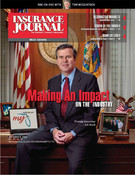When the Sept. 10, 2001 issue of the Insurance Journal carried Demotech’s predictions on the maximum number of insolvencies that would occur in the property/casualty industry over the period June 2002 through Dec. 31, 2002, who would have speculated that Sept. 11, 2001 would be one of the darkest days in American history? Pre-9/11, the popular wisdom in the financial markets was a moderation in the rate of growth associated with stock markets. Few predicted the most bearish of markets would suddenly be upon us.
In light of the unique financial consequences of 9/11 in conjunction with the dramatic economic downturn, would Demotech’s P/C insurer solvency predication remain viable? The answer is yes. As a matter of fact, a review of our historical experience, from 1989 when Demotech first issued Financial Stability Ratings® through Dec. 31, 2002, our rating assignment process has exceeded expectations.
Our 2001-2002 results
In the above-mentioned Insurance Journal article, Demotech Inc. predicted that from June of 2001 through Dec. 31, 2002 there would be no more than 65 insolvencies in the group of 2,053 companies that were assigned ratings. Despite the substantial downturn in the economy and the direct and indirect financial impact of 9/11 on the P/C community, there were only 27 insolvencies among the insurers that were rated. Please refer to Exhibit 1 for the retrospective analysis of the effectiveness of our Preliminary Financial Stability Ratings® over the period 1989 through Dec. 31, 2002.
Our inception to date through Dec. 31, 2002 results
Exhibit 2 (See pg. 79) presents the rating definitions that Demotech Inc. utilized over the period 1989 through Dec. 31, 2002. Note that each P/C company earning an A” (A double prime) Financial Stability Rating® was expected to survive from the date the Financial Stability Rating® was assigned until the end of the following calendar year, i.e., 18 months. From 1989 to date, Demotech has assigned 2,662 A” Financial Stability Ratings®. Each and every one of these companies has met our survival requirement.
Similarly, Demotech assigned 3,596 A- (A prime) Financial Stability Ratings® over this same thirteen year period and expected a survival rate of at least 99 percent over the ensuing 18 months. The actual survival rate was 99.8 percent.
With regard to companies rated A (Exceptional), we expected a survival rate of at least 97 percent 18 months later. The actual survival rate was 99.6 percent. As discussed above in our 2001-2002 results, the year-end 2002 survival rate, applicable to companies rated during 2001, was 99.6 percent for companies Demotech had rated A—even though 9/11 and the economic downturn ensued well after our predictions had been made.
Our view on the next 18 months
With regard to economic conditions and the underwriting cycle, it is our opinion that general economic conditions will improve over the next eighteen months. The upcoming Presidential election of 2004 will likely mean the federal government remains focused on moderate inflation, stable interest rates and economic growth.
With regard to opportunities to improve investment yields, insurance company opportunities will improve as public entities and other issuers of debt—states, cities, counties, water treatment authorities, school districts, etc.—rebound. The investment yields available to insurers will improve.
As for the P/C industry’s underwriting cycle, barring catastrophes—natural or otherwise—our belief is that year-end 2003 reinsurance negotiations will be the final negotiations of this hard market. During 2004 the improving economy and enhanced investment opportunities will entice reinsurers to loosen up a bit.
Demotech believes that the personal lines and commercial lines rate increases that dominated 2002 and 2003 will moderate to a level that is somewhat higher than inflation as measured by the Consumer Price Index yet remain modestly below double digits.
Will industry-operating results, as measured by the combined ratio, continue to improve? Our response to this question is yes but not as much as it has improved over the past two years. The wild card, as always, is loss and loss adjustment expense reserve adequacy. The number of P/C companies that need to strengthen their reserves is a relatively low percentage of the total industry when measured in absolute numbers of companies.
However, if one subscribes to the premise that asbestos, environmental liability, construction defect, mold and other exposures will continue to present the industry with challenges related to quantification of ultimate liabilities or challenges related to disclosure of the best estimate, there may be relatively high loss reserve development impacting the balance sheets and operating statements of a small percentage of insurers. In virtually all situations, these national and international insurers and reinsurers will be able to absorb the adverse reserve development and retain a policyholder’s surplus greater than zero.
Summary
Although informed consumers can access several rating services to assess the financial strength, claims-paying ability or financial stability of a particular property and casualty insurance company, only Demotech, Inc. has quantifiable criteria for verifying the accuracy of its Financial Stability Ratings®. As important as our quantifiable criteria is the fact that for each year that we promulgated Financial Stability Ratings®, we met or exceeded our stated objective related to assessing the likelihood of solvency.
As the operating results and the financial stability of P/C companies continue to be impacted by reserve strengthening, we provide company specific loss reserve development information on the overwhelming majority of P/C companies. To assist consumers, insurance agents, the reinsurance community and other interested parties, Demotech Inc. now publishes a Quarterly Reserve Position on its Web site, www.demotech.com.
By viewing the retrospective accuracy of our Financial Stability Ratings®, interested parties will come to understand that our rating process has tremendous predictive ability. Similarly when viewing the Quarterly Reserve Position of P/C companies, informed consumers will be able to retrospectively review the reported reserve position of virtually all P/C companies.
Demotech P&C Financial Stability Rating® Definitions
– A” Regardless of the severity of a general economic downturn or deterioration in the insurance cycle, insurers earning a Financial Stability Rating® of A double prime possess Unsurpassed financial stability related to maintaining positive surplus as regards
policyholders. Regardless of the severity
of a general economic downturn or deterioration in the insurance cycle, one hundred
percent of the insurers receiving a Financial Stability Rating® of A double prime
are expected to have positive surplus as regards policyholders 18 months after the initial assignment of a Financial Stability Rating®.
– A’ Regardless of the severity of a general economic downturn or a deterioration in the insurance cycle, insurers earning a Financial Stability Rating® of A prime possess Unsurpassed financial stability related to maintaining positive surplus as regards policyholders. Regardless of the severity of a general economic downturn or deterioration in the insurance cycle, at least 99 percent of the insurers receiving a Financial Stability Rating® of A prime are expected to have positive surplus as regards policyholders eighteen months after the initial assignment of a Financial Stability Rating®.
– A Regardless of the severity of a general economic downturn or deterioration in the insurance cycle, insurers earning a Financial Stability Rating® of A possess Exceptional financial stability related to maintaining positive surplus as regards policyholders. Regardless of the severity of a general economic downturn or deterioration in the insurance cycle, at least 97 percent of the insurers receiving a Financial Stability Rating® of A are expected to have positive surplus as regards policyholders 18 months after the initial assignment of a Financial Stability Rating®.
– S Regardless of the severity of a general economic downturn or a deterioration in the insurance cycle, insurers earning a Financial Stability Rating® of S possess Substantial financial stability related to maintaining positive surplus. Regardless of the severity of a general economic downturn or a deterioration in the insurance cycle, at least 95 percent of the insurers receiving a Financial Stability Rating® of S are expected to have positive surplus as regards policyholders 18 months after the initial assignment of a Financial Stability Rating®.
– M Regardless of the severity of a general economic downturn or a deterioration in the insurance cycle, insurers earning a Financial Stability Rating® of M possess Moderate financial stability related to maintaining positive surplus as regards policyholders. Regardless of the severity of a general economic
downturn or a deterioration in the insurance cycle, at least 90 percent of the insurers receiving a Financial Stability Rating® of M are expected to have positive surplus as regards policyholders 18 months
after the initial assignment of a Financial Stability Rating®.
-L Insurers earning a Financial Stability Rating® of L are Licensed by state regulatory authorities.
N/A Insurers receiving a designation of N/A are ineligible for a Financial Stability Rating® because of incomplete or insufficient data.
Joseph L. Petrelli is the president and founder of Demotech Inc. For more information, visit www.demotech.com
Was this article valuable?
Here are more articles you may enjoy.


 US P/C Insurers Post Best Q1 Underwriting Result In 17 Years
US P/C Insurers Post Best Q1 Underwriting Result In 17 Years  Allstate, Nationwide Post Dramatic Q12024 Homeowners Loss Ratio Drops: S&P
Allstate, Nationwide Post Dramatic Q12024 Homeowners Loss Ratio Drops: S&P  Microsoft Tells Texas Agencies They Were Exposed in Russian Hack
Microsoft Tells Texas Agencies They Were Exposed in Russian Hack  ‘Extremely Dangerous’ Hurricane Beryl Takes Aim at Caribbean
‘Extremely Dangerous’ Hurricane Beryl Takes Aim at Caribbean 



